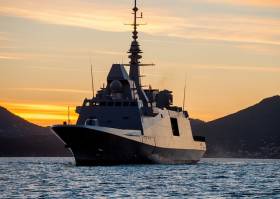Displaying items by tag: Stealth frigate
Stealth Frigate Underway to Dublin for Call and Public Tours
#StealthShip - Presenting ‘stealth’ characteristics is frigate Provence of the French Navy which is to make a courtesy call to Dublin tomorrow and will be open at the weekend, writes Jehan Ashmore.
On Saturday the public are invited to board the slick 6,000 gross tonnage 'Aquitaine' class FREMM frigate. The visit will allow for a crew rest in the capital.
Measuring 142m long vessel, Provence is of the French Frégate européenne multi-mission (FREMM) programme in which the ship is the second of the class. The vessel was built in Brest by DCNS in 2015.
Provence is one of three active multiple-purpose frigates serving French Navy and they are equipped to operate during anti-submarine missions.
Among the equipment which is fitted with the latest technology includes MU90 torpedoes, variable depth sonar and bow mounted sonars.
At the stern is where a NH90 helicopter can be landed and this aircraft is fitted with buoys and flash sonar.
























































